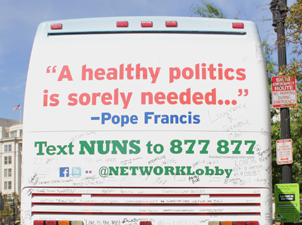
Promoting Dignity of Labor in NAFTA Negotiations
Mary Cunningham
July 30, 2018
When the North American Free Trade Agreement (NAFTA) was signed in 1994, the United States, Canada, and Mexico hailed it as a groundbreaking deal that would bring job growth, economic vitality and improved living standards to all three countries. Despite these promises, the trade deal failed to live up to the hype and has resulted in stifled wages in Mexico and the U.S., mass migration from Mexico to the U.S., and no improvement in labor and environmental protections. After the passage of NAFTA, the U.S. flooded the Mexican market with corn, decreasing the value of Mexican corn by 66% which led directly to farmer displacement and migration. Wages in Mexico have fallen below pre-NAFTA levels as have worker’s wages in the U.S. Likewise, America’s small farmers have been forced to compete with large industrial agricultural corporations against which they don’t stand a chance. NAFTA was negotiated by and for the big corporations and has failed workers on all sides of the table.
This brings us to the current state of NAFTA today. During his campaign and continuing into his presidency, President Trump dismissed NAFTA, declaring it “the worst trade deal.” He believes NAFTA is to blame for the loss of U.S. manufacturing jobs and the exportation of jobs to countries with lower production costs, like Mexico. President Trump’s distaste for NAFTA set the stage for NAFTA renegotiations led by U.S. Trade Representative, Robert Lighthizer. Thus far, there have been 7 rounds of talks, but no conclusive agreement has been reached. Following the election of the new Mexican president, Andrés Manuel López Obrador (AMLO), negotiators from Mexico, Canada, and the U.S. have a window to try to conclude an agreement; however, the negotiations are more likely to continue into 2019. As the Wall Street Journal reports, several of Andrés Manuel López Obrador’s priorities align with President Trump’s, increasing the likelihood of reaching a consensus on negotiations. Although there has been tension between President Trump and Prime Minister Justin Trudeau following the G-7 meeting, Canada and the U.S. are important trade partners and it is in both of their country’s interest to continue talks.
The main goals of the negotiations include updating trade practices to reflect new advancements in technology and “fixing” parts of the agreement that haven’t worked. For the administration, this means eliminating certain investor protections that force federal governments to pay fines to transnational companies. It also means improving Mexican labor laws to combat the low wages and unfair labor standards which the administration argues have led to mass migrations and a precipitous decline in U.S. manufacturing jobs. Part of the U.S. proposal is to have automobile parts manufactured in work zones with a minimum wage of $15. This would spur manufacturing in the U.S. and simultaneously increase wages in Mexico. Mexican negotiations have expressed openness to these objectives although the business communities in all three countries vigorously object to provisions that protect workers and end investor courts.
Only by paying attention to the plight of the workers impacted by NAFTA can a comprehensive deal be reached. Although negotiations are complicated, a deal that treats all workers with the respect and dignity they deserve is possible. This means guaranteeing stable wages, the right to unionize, and worker protections. NAFTA has not lived up to its expectations, but these negotiations are a promising step forward.







